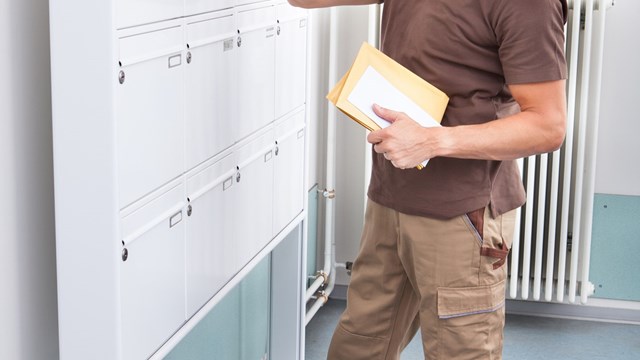Not so very long ago, acquiring goods and services required some physical effort on the part of consumers; a trip to a store, or restaurant, or other commercial establishment. Sure, you could phone or mail in an order from the Sears catalog or have Domino’s deliver a pizza, but that was about it.
Over the last decade or so, more and more of our buying has moved online—and more and more of what we acquire comes to our homes via a third party, without us ever having to leave the couch, let alone the house. When COVID-19 sequestered us even further into our private bubbles and forced us to avoid human contact outside of our households, it further accelerated the pace of all kinds of virtual vending and the ease with which we can conduct transactions remotely. We’ve come to expect everything from groceries to new shoes to medications to arrive at our door promptly, securely, and intact.
And the trend isn’t going anywhere. Multifamily property analytics firm ApartmentData.com estimates that in 2022, each resident on average will receive 9.41 packages each month, with that number going up to 10.65 in 2023. It’s one thing for a single family in a free-standing house to receive and secure the steady stream of packages and other deliveries that come directly to their door. But for multifamily buildings and communities, the situation is much more complex—and often fraught, even before the pandemic. COVID has exacerbated and further complicated the difficulties associated with the delivery deluge.
So how have residential communities adapted to this particular challenge? What new systems or technologies have developed to help boards and managers make sure packages and deliveries get to their intended recipients without leaving building staff members swimming in a sea of cardboard?
Many Options, Few Solutions
Multifamily buildings come in many shapes and sizes, of course—not to mention ages, locations, histories, financial positions, and residential cultures. When it comes to package security and storage, this means that what might work great for one building or community might not even be an option for another. And with residents continuing to spend more time at home and the options for e-commerce ever increasing, what might work for one building today might be obsolete by the time it’s installed and implemented.
“Storage needs for package delivery have changed over the years,” says Susan Lauren, the principal of New York-based Lauren Interior Design, a design firm that creates custom interiors for building common spaces such as lobbies, hallways, and amenities areas. “What was appropriate 10 years ago is no longer sufficient for most buildings. The space set aside just isn’t large enough.”
Even communities built in the last 10 years that specifically allocated space for package storage and security from the start have found that they don’t have the staff necessary to accept, track, and deliver all the packages. Joseph Ferdinando, founder of Building Security Services & Systems, a security systems, technology, and personnel company that has been working with buildings and communities in New York and New Jersey for nearly 40 years, says that the conditions during COVID have measurably exacerbated the issue. “In general, in residential [buildings],” he says, “80% of people are home working, so our activity during the day has increased. There has been a tremendous amount of deliveries. For the properties that have us providing concierge, doorman, or security officers, we have found the activity during the day has increased by 200%, be it food deliveries, UPS, USPS, FedEx, or Amazon.”
That “tremendous amount of deliveries” makes the day extremely busy for security and other front-of-house personnel, says Ferdinando—especially during business hours, when there is increased activity in general. It also creates security and safety concerns with constant traffic into and out of the building, and piles of packages in lobbies, hallways, and other common areas. On top of all that, those piles of unattended packages are a beacon for thieves and vandals—an issue that only becomes worse during the holidays.
Desperate Times, Desperate Measures
“Having a designated front desk or property management staff member accept and store packages at a multi-unit residential building is a common solution,” says Amy Peterselli, an attorney in Brookfield, Illinois, formerly with Chicago-based community association law firm Kovitz Shifrin Nesbit. “However, as the increase in packages has eaten up a noticeable amount of time that front desk employees would otherwise dedicate to other administrative tasks, some associations have also begun charging residents storage fees on a per-package basis. Alternatively, some communities have added a flat package delivery fee to residents’ monthly assessments as a ‘common expense.’”
The pros report that some communities have even discontinued package services altogether when the delivery volume exceeded manageable levels. Staffing and space limitations can simply make it impossible for on-site teams to receive, store, and distribute packages on behalf of residents while still staying on top of their other responsibilities. Some attorneys say the safety and liability issues alone are reason enough to disallow delivery personnel from entering residential buildings. The onset of COVID made this all the more plain.
“We recommend that no delivery personnel be permitted past the entrance of the building,” said Dale Degenshein, an attorney with Manhattan-based law firm Armstrong Teasdale, in the early days of the pandemic, “and that in most cases, residents pick up their packages or food deliveries in the lobby or outside of the building.” Of course, such arrangements only work when residents expect to be home during delivery hours. As the pandemic ebbs, or we just learn to live with it, other approaches will have to be considered to keep both staff and residents—and their deliveries—safe.
Even before COVID, and before the package pandemonium instigated by Amazon and other global e-tailers, it was common practice in many communities to arrange for a nearby business—a corner store, deli, or bodega, for example—to accept deliveries on residents’ behalf. Now UPS has a service called My Choice, says Peterselli, that allows registered users to have their packages delivered to another location—be it the local convenience store, the office, or a designated neighbor. While it can definitely help, this option might not be practical for all the types of things we order off the internet. Furniture? Perishable goods? Live animals? Good luck getting your deli guy to accept and keep those deliveries.
Tech-Based Solutions for a Tech-Induced Problem
While delivery to another address or unit might solve the problem of an undeliverable or unsecured package, it removes the convenience of door-to-door delivery that residents have come to expect and rely upon. Package management has shifted from a courtesy to a competitive necessity, reports the National Multifamily Housing Council (NMHC), so buildings of all types need options for package delivery that are as secure as they are convenient, without breaking the bottom line.
There are a lot of newcomers to the building security tech, or ‘proptech’ arena, many aiming to help underserved or overlooked types of buildings. One example is a product called Buzr, which is about to launch from its startup lab on Roosevelt Island in New York City. CEO Tony Liebel says that the company is “focused on getting to residents who are left behind in the proptech renaissance.” The Buzr system is geared toward older, smaller buildings without lobby attendants or high-tech security systems, and is installed as a relatively inexpensive modification to an existing intercom access panel. “I like to think of it as Nest or Ring [popular app-based systems for remote home monitoring], but for access,” says Liebel.
Installation is designed to be easy enough for a resident to do themselves, he explains, using their unit’s existing wiring—no matter how old—and an upgraded hardware replacement for the intercom station. (Residents not comfortable tinkering with wires can opt for the company’s installation helper for an additional fee.) The interface remains the same, it just becomes “smart”—meaning that access data is stored in the cloud, allowing a building to maintain a record of when the lobby door is buzzed, and which unit is providing access.
It also allows for ‘virtual keys’—an unduplicable code that can be sent in a link or programmable in an app or text message. Virtual keys can allow a food delivery person, for example, to have limited, recorded access to a building for the purpose of a dropoff, eliminating the need for a staff member to handle the receipt and enhancing security by logging the access. In places like New York City, it also reduces the waste and inconvenience produced by the 30% of packages the Wall Street Journal found go undelivered on the first attempt. Theft is reduced as well, according to Liebel, who says that 90,000 packages are stolen here in the Big Apple every year. “What we do is at least make sure packages get in the front door,” he says.
Communities with the space and financial resources to create onsite locker storage facilities can also partner with one of the many third-party vendors that have come on the scene in recent years to take receipt, storage, and notification—not to mention liability and customer support—off the plates of building personnel and management. Amazon itself offers such a product, called Amazon Hub. Newcomers like Package Concierge, Parcel Pending, and Luxor One also store all types of packages in electronically-accessed locker systems that provide a text message and unique PIN to the recipient when the courier places their package in a locker. But the installation of these units averages around $15,000, and using the system might be intimidating for less tech-savvy residents. The storage space may also not be sufficient for heavy volume times like holidays, or an even more package-intense future.
Offsite storage facilities with direct-to-resident delivery services offer yet another possible solution to the package problem, but their longevity in the space has not been proven. Some, like Doorman, have already come and gone. Fetch is a newcomer offering a similar business model, but is as yet only available in about a dozen states, including Illinois and Florida.
The upshot may be that unless and until we scale back our online shopping and curb our collective addiction to ultra-convenience (and we’re not holding our breath on that one), the solution to package security in multifamily buildings will likely be some combination of space, storage, staff, and tech that each community must ongoingly assess.
Darcey Gerstein is Associate Editor and a Staff Writer for CooperatorNews.










Comments
Leave a Comment